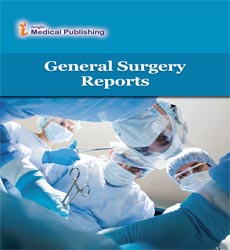Rhinoplasty Revealed: Surgical Options for Nasal Reshaping
Bernardo Isabel*
Department of General Surgery, LK Baden University, Baden, Austria
- *Corresponding Author:
- Bernardo Isabel
Department of General Surgery, LK Baden University, Baden,
Austria,
E-mail: Isabel@gmail.com
Received date: May 21, 2024, Manuscript No. IPGSR-24-19073; Editor assigned date: May 23, 2024, PreQC No. IPGSR-24-19073 (PQ); Reviewed date: June 06, 2024, QC No. IPGSR-24-19073; Revised date: June 03, 2024, Manuscript No. IPGSR-24-19073 (R); Published date: June 20, 2024, DOI: 10.36648/2393-8854.11.2.168
Citation: Isabel B (2024) Rhinoplasty Revealed: Surgical Options for Nasal Reshaping. Gen Surg Rep 11.2: 168.
Description
Rhinoplasty, commonly known as a "nose" is a surgical procedure designed to alter the shape, size, or proportions of the nose. It can be performed for aesthetic reasons, to improve the of the nose, or for functional reasons, such as correcting breathing difficulties caused by structural abnormalities. This the rhinoplasty procedure, its benefits, potential risks, and the recovery process, offering a detailed overview for those considering this transformative surgery. The rhinoplasty procedure involves reshaping the bone, cartilage, and skin of the nose to achieve the desired appearance or improve functionality. The surgery can address a wide range of concerns, including nasal asymmetry, a hump on the bridge, a bulbous or drooping nasal tip, and nostrils that are too wide or narrow. There are two primary techniques for performing rhinoplasty: Open and closed. Open rhinoplasty involves making an incision across the columella, the strip of tissue separating the nostrils, allowing the surgeon to lift the skin and have a clear view of the nasal structures. Closed rhinoplasty, on the other hand, involves incisions made within the nostrils, resulting in no visible scarring. The choice between these techniques depends on the complexity of the case and the surgeon's preference.
Nasal valve collapse
Rhinoplasty is typically performed under general anesthesia, although local anesthesia with sedation may be an option for less extensive procedures. The duration of surgery varies, usually lasting between one and three hours, depending on the complexity of the case. During the surgery, the surgeon carefully separates the skin from the underlying bone and cartilage, reshaping the nasal framework to achieve the desired outcome. In some cases, cartilage grafts from other parts of the body, such as the ear or rib, may be used to support or build up certain areas of the nose. Once the reshaping is complete, the skin is redraped over the new nasal structure and incisions are closed. Recovery from rhinoplasty can take several weeks, with full results becoming apparent over a period of months as swelling subsides. Immediately after surgery, patients can expect bruising, swelling and discomfort, particularly around the eyes and nose. A nasal splint is often applied to help protect the nose during the initial healing phase and nasal packing may be used to support the new structure and control bleeding. The recovery process following rhinoplasty is a critical phase that requires careful adherence to post-operative instructions to ensure optimal results. Immediately after surgery, patients can expect swelling, bruising and discomfort, which can be managed with prescribed medications and cold compresses. The initial recovery period typically lasts one to two weeks, during which patients should avoid strenuous activities, bending over and any actions that may put pressure on the nose. Most patients can return to work or school within this timeframe, although full recovery and the final results of the surgery may take up to a year as the nasal tissues continue to heal and settle into their new shape.
Surgical techniques
Most patients can return to light activities within a week, but strenuous activities and contact sports should be avoided for at least six weeks. Swelling can persist for several months and while the nose may look improved after a few weeks, the final result can take up to a year to fully emerge. As with any surgery, rhinoplasty carries certain risks. These may include infection, bleeding, adverse reactions to anesthesia and scarring. Specific to rhinoplasty, complications such as difficulty breathing, asymmetry, or dissatisfaction with the aesthetic result can occur. In some cases, patients may require a revision rhinoplasty to address issues or refine the results of the initial surgery. The ideal candidates for rhinoplasty are individuals in good general health with realistic expectations about the results of the procedure. Rhinoplasty is not recommended for individuals whose facial growth has not yet completed, typically under the age of 16 to 18. It is essential to discuss goals, expectations and any medical concerns with a qualified plastic surgeon to determine the best approach for each individual case. Rhinoplasty is a highly individualized procedure that can significantly enhance a person’s appearance and quality of life by improving both the aesthetic and functional aspects of the nose. With advances in surgical techniques, the procedure can achieve natural-looking results with minimal scarring and downtime. However, a thorough consultation with an experienced surgeon is essential to ensure the best possible outcome.
Open Access Journals
- Aquaculture & Veterinary Science
- Chemistry & Chemical Sciences
- Clinical Sciences
- Engineering
- General Science
- Genetics & Molecular Biology
- Health Care & Nursing
- Immunology & Microbiology
- Materials Science
- Mathematics & Physics
- Medical Sciences
- Neurology & Psychiatry
- Oncology & Cancer Science
- Pharmaceutical Sciences
